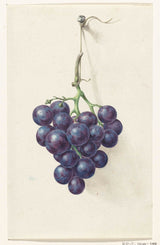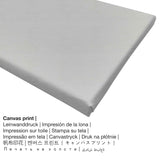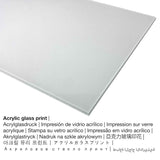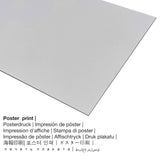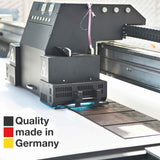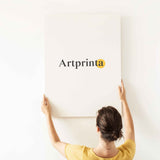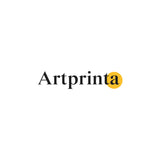Jean Bernard, 1775 - ụyọkọ mkpụrụ vaịn na-acha anụnụ anụnụ - mbipụta nka mara mma
Ụtụ gụnyere. Mbupu gbakọrọ na ndenye ọpụpụ.
Akụrụngwa ị nwere ike iburu
N'ime ndetu ndetu dị n'akụkụ isiokwu a, ị nwere ike họrọ ihe na nha nke nhọrọ gị. Nhọrọ ndị a dị maka n'otu n'otu:
- Akwụkwọ mmado na ihe kwaaji: Our poster is a printed cotton canvas with a nice surface structure. It is designed for putting the art print with the help of a special frame. Please keep in mind, that depending on the size of the canvas poster print we add a white margin 2-6cm round about the work of art, which facilitates the framing with your custom frame.
- Kwaaji: A canvas direct print is a printed cotton canvas mounted on a wood stretcher. A canvas makes a typical look of three-dimensionality. A printed canvas of this masterpiece will provide you with the opportunity of turning your art print into a large work of art like you would see in a real gallery. How do I hang a canvas on the wall? The advantage of canvas prints is that they are relatively low in weight, which implies that it is easy to hang your Canvas print without additional wall-mounts. Therefore, canvas prints are suited for any kind of wall in your house.
- Aluminom dibond (ọkpụkpụ ọla): An Aluminium Dibond print is a print material with an outstanding effect of depth - for a modern impression and non-reflective surface. The white & bright sections of the artwork shimmer with a silky gloss but without any glow. The print on aluminium is one of the most popular entry-level products and is a contemporary way to showcase art reproductions, because it puts the viewer’s attention on the whole artwork.
- Mbipụta iko acrylic (nke nwere ezigbo mkpuchi iko): The print on acrylic glass, often referred to as a print on plexiglass, will turn your favorite original work of art into amazing wall décor. Additionally, the acrylic print forms a great alternative option to aluminium and canvas prints. Your artwork is being printed with state-of-the-art UV print technology. This creates deep, vibrant colors. The major advantage of an acrylic glass fine art copy is that sharp contrasts and minor color details will be more exposed due to the very fine tonal gradation.
Disclaimer: We try all that we can to depict our art products as clearly as it is possible and to exhibit them visually. However, the tone of the printed materials, as well as the printing can differ slightly from the presentation on the monitor. Depending on the settings of your screen and the nature of the surface, not all color pigments can be printed as exactly as the digital version on this website. In view of the fact that the are processed and printed by hand, there might also be slight variations in the exact position and the size of the motif.
Nkọwapụta ngwaahịa nka
Nke a kpochapụwo ọrụ nka Bunch of blue grapes e mere site nna ukwu Jean-Bernard in the year 1775. Nowadays, the piece of art is part of the collection of Rijksmuseum. This classic art public domain piece of art is being supplied with courtesy of Rijksmuseum.Ebe E Si Nweta nke ihe osise:. Kedu ihe ọzọ, nhazi ahụ bụ Eserese ma nwee oke akụkụ nke 2: 3, nke pụtara na ogologo bụ 33% mkpụmkpụ karịa obosara.
Iberibe ozi ndabere nka
| Aha nka: | "Bunch of blue grapes" |
| Nhazi nke ọrụ nka: | sere |
| Okwu mkpokọta: | nka ochie |
| Time: | 18th narị afọ |
| Ekepụtara: | 1775 |
| Ogologo afọ nka nka: | karịa afọ 240 |
| Ụlọ ihe ngosi nka: | Rijksmuseum |
| Ebe ebe ngosi nka: | Amsterdam, Netherlands |
| Ebe nrụọrụ weebụ ihe ngosi nka: | Rijksmuseum |
| Ikikere nke ihe osise: | ngalaba ọha |
| Site n'aka: | Rijksmuseum |
Ihe nkọwa
| Nkewa edemede: | nka nka |
| Usoro mmeghari: | dijitalụ mmeputakwa |
| Produzọ mmepụta: | mbipụta dijitalụ (Mbipụta UV ozugbo) |
| Production: | German mmepụta |
| Stockdị ngwaahịa: | na mmepụta ihe |
| Eji ngwaahịa emebere: | mgbidi mgbidi, mgbidi ịchọ mma |
| Nhazi nka nka: | usoro eserese |
| Njikwa oyiyi: | 2: 3 |
| Ntụgharị nkọwa akụkụ onyonyo: | ogologo bụ 33% mkpụmkpụ karịa obosara |
| Akụrụngwa ị nwere ike ịhọrọ site na: | mbipụta ọla (aluminium dibond), mbipụta akwụkwọ mmado (akwụkwọ kwaaji), mbipụta kanvas, mbipụta iko acrylic (nwere ezigbo mkpuchi iko) |
| Nhọrọ nke akwa akwa n'elu etiti ihe ndọtị (mbipụta akwa akwa): | 20x30cm - 8x12", 40x60cm - 16x24", 60x90cm - 24x35", 80x120cm - 31x47", 100x150cm - 39x59" |
| Acrylic glass print (nwere ezigbo mkpuchi iko) nhọrọ: | 20x30cm - 8x12", 40x60cm - 16x24", 60x90cm - 24x35", 80x120cm - 31x47", 100x150cm - 39x59" |
| Mbipụta akwụkwọ mmado (akwụkwọ kwaaji): | 40x60cm - 16x24", 60x90cm - 24x35", 80x120cm - 31x47" |
| Aluminium dibond ebipụta (ihe aluminium) nha dị iche iche: | 20x30cm - 8x12", 40x60cm - 16x24", 60x90cm - 24x35", 80x120cm - 31x47" |
| ụba: | mbipụta nka na-enweghị isi |
Ozi ndabere izugbe na onye na-ese ihe
| Ihe nkiri: | Jean-Bernard |
| Aha ndị ọzọ: | Jan Bernard, Jean Bernard, Bernard Jean II, Jean II Bernard, Bernard Jan, Bernard Jean |
| Gender: | nwoke |
| Obodo onye nka: | French |
| Ọrụ nke onye na-ese ihe: | watercolourist, painter, etcher, drawer |
| Mba onye si: | France |
| Nkewa onye nka: | nna ukwu ochie |
| Ndụ: | 68 afọ |
| Afọ amụrụ: | 1765 |
| Ebe amụrụ onye: | Amsterdam, North Holland, Netherlands |
| Nwuru: | 1833 |
| Obodo ọnwụ: | Amsterdam, North Holland, Netherlands |
© nwebiisinka | Artprinta (www.artprinta.com)

